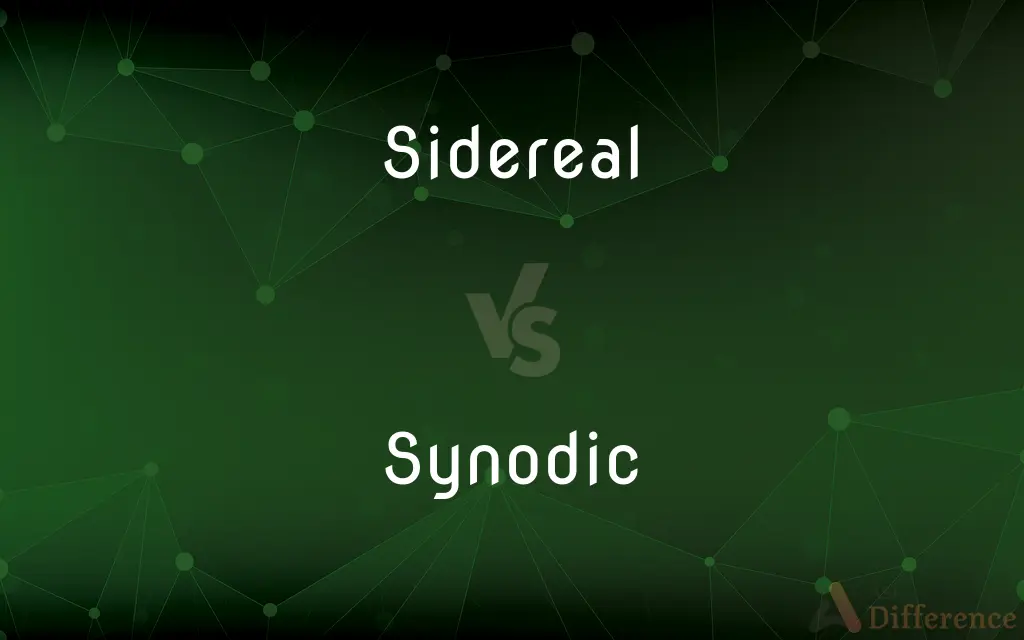Sidereal vs. Synodic — What's the Difference?
By Tayyaba Rehman — Updated on October 27, 2023
Sidereal relates to the stars and measures time based on Earth's rotation relative to distant stars; Synodic is based on the Moon or planets' positions relative to the Sun.

Difference Between Sidereal and Synodic
Table of Contents
ADVERTISEMENT
Key Differences
Sidereal refers to timekeeping based on the Earth's rotation relative to distant stars. Synodic pertains to the time it takes for a celestial body to return to the same position relative to the Sun.
Sidereal measurements are constant, using distant stars as a reference. Synodic measurements change, depending on the relative positions of celestial bodies and the Sun.
Sidereal is used in astronomy for precise tracking of stars and constellations. Synodic is commonly used in understanding lunar phases and planetary cycles.
A sidereal day is slightly shorter than a solar day, about 23 hours, 56 minutes. A synodic month, the time between full moons, is about 29.5 days.
Both sidereal and synodic measurements have ancient roots, but sidereal has been pivotal in navigation and understanding celestial mechanics. Synodic cycles have been essential in calendars and agricultural planning.
ADVERTISEMENT
Comparison Chart
Reference
Distant stars
Sun
Measurement Basis
Earth's rotation
Celestial body's position
Application
Star tracking
Lunar phases, planetary cycles
Cycle Length
About 23h 56m (day)
About 29.5 days (month)
Historical Use
Navigation, astronomy
Calendars, agriculture
Compare with Definitions
Sidereal
Based on Earth's rotation relative to fixed stars.
A sidereal day is slightly shorter than a solar day.
Synodic
Based on the position of a celestial body relative to the Sun.
The synodic period of a planet differs from its orbital period.
Sidereal
Concerning or using stars as a reference point.
Sidereal charts map the positions of stars and constellations.
Synodic
Pertaining to the cycle of lunar phases.
Lunar calendars are based on the synodic month.
Sidereal
Used historically in celestial navigation.
Ancient mariners relied on sidereal patterns for navigation.
Synodic
Relating to the conjunctions of celestial bodies.
The synodic month is the time between full moons.
Sidereal
Relating to distant stars or constellations.
Astronomers use sidereal time to locate stars in the night sky.
Synodic
In astrology, aspects based on synodic cycles.
Astrologers study synodic cycles to interpret planetary influences.
Sidereal
Of, relating to, or concerned with the stars or constellations; stellar.
Synodic
Used historically in agricultural planning.
Ancient farmers used the synodic cycle to time planting and harvesting.
Sidereal
Measured or determined by means of the apparent daily motion of the stars
Sidereal time.
Synodic
Of or relating to a synod; synodal.
Sidereal
Of or relating to the stars.
Synodic
Relating to the period of time required for an object to complete a single orbital period, returning to the same position as observed from another object or position in space.
Sidereal
(astronomy) Relating to a measurement of time relative to the position of the stars.
Synodic
Of, related to or produced by a synod; synodal
Sidereal
(astronomy) Relating to a measurement of time relative to the point of the vernal equinox.
Synodic
(astronomy) Of or pertaining to the conjunction of two or more heavenly bodies
A synodical month
The synodical revolution of the moon or a planet
Sidereal
Relating to the stars; starry; astral; as, sidereal astronomy.
Synodic
Of or pertaining to a synod; transacted in, or authorized by, a synod; as, synodical proceedings or forms.
Sidereal
Measuring by the apparent motion of the stars; designated, marked out, or accompanied, by a return to the same position in respect to the stars; as, the sidereal revolution of a planet; a sidereal day.
Synodic
Pertaining to conjunction, especially to the period between two successive conjunctions; extending from one conjunction, as of the moon or a planet with the sun, to the next; as, a synodical month (see Lunar month, under Month); the synodical revolution of the moon or a planet.
Sidereal
Of or relating to the stars or constellations;
Sidereal bodies
The sidereal system
Sidereal
(of divisions of time) determined by daily motion of the stars;
Sidereal time
Sidereal
Pertaining to the sidereal period of a celestial object.
The sidereal period of the moon is different from its synodic period.
Common Curiosities
What's a synodic month?
A synodic month is the time between similar lunar phases, such as full moons, about 29.5 days.
How is sidereal used in astronomy?
Sidereal is used in astronomy for precise tracking and location of celestial objects.
How is synodic time calculated?
Synodic time is based on the cycle of a celestial body's position relative to the Sun.
Why is a sidereal day shorter?
A sidereal day is shorter because it's measured relative to distant stars, not the Sun.
What does sidereal mean?
Sidereal relates to distant stars or constellations, especially in timekeeping.
What instruments measure sidereal time?
Sidereal time is measured using astronomical clocks and observatory instruments.
How do sidereal and synodic differ in length?
A sidereal day is about 23h 56m, while a synodic month is about 29.5 days.
How does synodic affect agriculture?
Synodic cycles, like the synodic month, historically helped in planning agricultural activities.
Why are synodic periods important?
Synodic periods are important for understanding lunar phases and planetary cycles.
What is a sidereal year?
A sidereal year is the time it takes Earth to orbit the Sun relative to distant stars.
Can sidereal time be used for navigation?
Yes, sidereal time has historically been used for celestial navigation.
Are there cultural aspects to synodic cycles?
Yes, synodic cycles have cultural significance, especially in lunar festivals and traditions.
Does synodic have astrological significance?
In astrology, synodic cycles are used to interpret planetary influences and aspects.
Is sidereal time constant?
Yes, sidereal time is constant, as it's based on the Earth's rotation relative to fixed stars.
What's the role of synodic in calendars?
Synodic cycles, especially the synodic month, have been used in creating lunar calendars.
Share Your Discovery

Previous Comparison
Joy vs. Pleasure
Next Comparison
Colonel vs. MajorAuthor Spotlight
Written by
Tayyaba RehmanTayyaba Rehman is a distinguished writer, currently serving as a primary contributor to askdifference.com. As a researcher in semantics and etymology, Tayyaba's passion for the complexity of languages and their distinctions has found a perfect home on the platform. Tayyaba delves into the intricacies of language, distinguishing between commonly confused words and phrases, thereby providing clarity for readers worldwide.















































